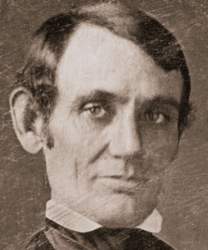Record Data
Source citation
Abraham Lincoln, Fragment on Niagara Falls, circa September 25-30, 1848, in Roy P. Basler, ed., The Collected Works of Abraham Lincoln (8 vols., New Brunswick, NJ: Rutgers University Press, 1953), 2: 10-12, http://quod.lib.umich.edu/l/lincoln/.
Type
Miscellaneous
Date Certainty
Disputed
Transcriber
Transcription adapted from The Collected Works of Abraham Lincoln (1953), edited by Roy P. Basler
Adapted by Matthew Pinsker, Dickinson College
Transcription date
Transcription
The following text is presented here in complete form, as it originally appeared in print. Spelling and typographical errors have been preserved as in the original.
[c. September 25-30, 1848]
Niagara-Falls! By what mysterious power is it that millions and millions, are drawn from all parts of the world, to gaze upon ← Niagara Falls → ? There is no mystery about the thing itself. Every effect is just such as any inteligent man knowing the causes, would anticipate, without [seeing] it. If the water moving onward in a great river, reaches a point where there is a perpendicular jog, of a hundred feet in descent, in the bottom of the river,---it is plain the water will have a violent and continuous plunge at that point. It is also plain the water, thus plunging, will foam, and roar, and send up a mist, continuously, in which last, during sunshine, there will be perpetual rain-bows. The mere physical of ← Niagara Falls → is only this. Yet this is really a very small part of that world's wonder. It's power to excite reflection, and emotion, is it's great charm. The geologist will demonstrate that the plunge, or fall, was once at Lake Ontario, and has worn it's way back to it's present position; he will ascertain how fast it is wearing now, and so get a basis for determining how long it has been wearing back from Lake Ontario, and finally demonstrate by it that this world is at least fourteen thousand years old. A philosopher of a slightly different turn will say ← Niagara Falls → is only the lip of the basin out of which pours all the surplus water which rains down on two or three hundred thousand square miles of the earth's surface. He will estim[ate with] approximate accuracy, that five hundred thousand [to]ns of water, falls with it's full weight, a distance of a hundred feet each minute---thus exerting a force equal to the lifting of the same weight, through the same space, in the same time. And then the further reflection comes that this vast amount of water, constantly pouring down, is supplied by an equal amount constantly lifted up, by the sun; and still he says, ``If this much is lifted up, for this one space of two or three hundred thousand square miles, an equal amount must be lifted for every other equal space, and he is overwhelmed in the contemplation of the vast power the sun is constantly exerting in quiet, noiseless opperation of lifting water up to be rained down again.
But still there is more. It calls up the indefinite past. When Columbus first sought this continent---when Christ suffered on the cross---when Moses led Israel through the Red-Sea---nay, even, when Adam first came from the hand of his Maker---then as now, Niagara was roaring here. The eyes of that species of extinct giants, whose bones fill the mounds of America, have gazed on Niagara, as ours do now. Co[n]temporary with the whole race of men, and older than the first man, Niagara is strong, and fresh to-day as ten thousand years ago. The Mammoth and Mastadon---now so long dead, that fragments of their monstrous bones, alone testify, that they ever lived, have gazed on Niagara. In that long---long time, never still for a single moment. Never dried, never froze, never slept, never rested,


